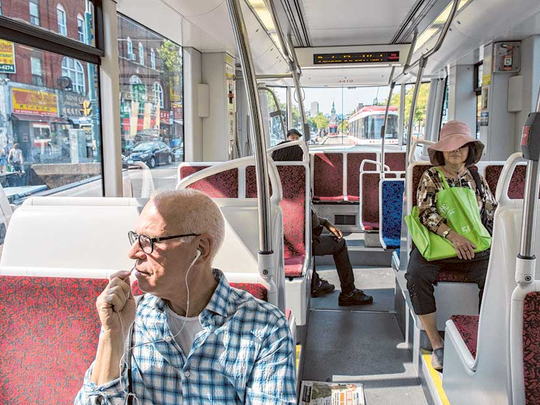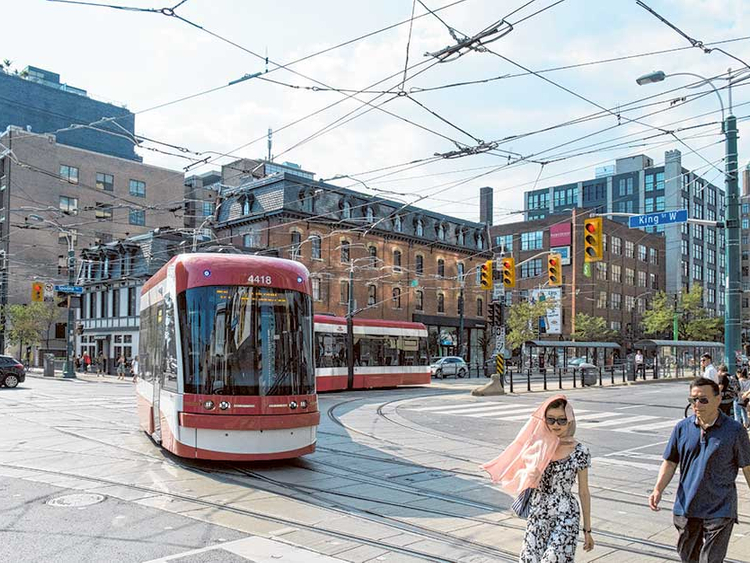
TORONTO
As the streetcar crept along Queen Street West in clogged traffic through the heart of downtown, anxiety started to rise among those inside. Commuters checked the time, calculating how late they would be for work.
The red-and-white trolley did not feel like rapid transit.
“It’s not very efficient,” said Shande McPhee, who was a half-hour late for her financial-industry job on a recent morning because of worse-than-usual congestion. If only the streetcar had a dedicated lane to bypass cars, she said.
Despite flare-ups of grumpiness, tens of thousands of people in Canada’s largest city rely on the vehicles to get around on North America’s largest streetcar system.
Now that New York City is bringing back the streetcar, with Mayor Bill de Blasio planning a $2.5 billion waterfront route linking Brooklyn and Queens by 2024, officials are looking to Toronto for lessons on how to make the new line a success. Even in Toronto, where trolleys have rattled down streets for nearly a century, the streetcars have often prompted rancorous debates - which will undoubtedly soon be coming to New York.
This summer, New York City hired Adam Giambrone, a former chairman of the Toronto Transit Commission, to run the project and sell the concept to residents along the line. His arrival was a sign that plans were moving forward, though his debut became a bit bumpy after New Yorkers learned of the sex scandal that had derailed Giambrone’s political career, prompting headlines that the city had recruited the Canadian Anthony Weiner.
As New York works to complete a rigorous study of the line by the fall, streetcar riders and transit experts in Toronto have repeated the same two warnings: build dedicated lanes to keep the streetcars from getting trapped in traffic and be prepared for outrage over the loss of street space and parking.
In Toronto, about 250,000 riders use the city’s 11 streetcar lines each day. Many of the lines run east-west on the same roadways as cars, connecting commuters to a broader network of subway and bus lines. A few routes, like the Spadina line, have their own lane separated from traffic by a raised curb.
“I would only take streetcars that have their own lane,” Matthew Hibbert said as he rode a new Spadina streetcar on a recent afternoon. “I would try to find a way to a subway if I had to take a streetcar that was in regular traffic.”
But the reaction from drivers when lanes of traffic are set aside for streetcars can be politically troublesome, said Josh Colle, a Toronto city councilor and the current chairman of the Transit Commission. Years after the city added a dedicated lane on the St. Clair line, it is still a delicate topic.
“It’s like a holy war,” Colle said in an interview at his office in City Hall. “It’s more than pushback. It’s vicious.”
Local businesses worry they will lose customers if street parking is removed. Drivers fear fewer car lanes will make commutes more painful.
Perhaps the most prominent streetcar critic was Rob Ford, the pugnacious former Toronto mayor who gained worldwide notoriety after he admitted to using crack cocaine while in office. (Ford died in March.) While his push to remove streetcars was not successful, supporters say it did lasting harm to their image, and delays on an order of new streetcars have not helped.
Yet many Torontonians love the streetcars and delight in their elegance and nostalgia, a kind of romance that is also palpable in cities like New Orleans and San Francisco.
“I actually enjoy riding the streetcar more than the subway, just to be able to be outside, instead of being stuck underground,” Rob Bird, an actor, said as he took the Queen line in Toronto, calling the trip “serene.”
A growing number of U.S. cities are turning to streetcars, which supporters argue are environmentally friendly, less expensive than building a subway and more attractive to commuters than buses. Still, in cities like Washington and Atlanta, new lines have faced a backlash over delays, cost overruns and low ridership.
In New York, de Blasio, a Democrat, has proposed a 16-mile route, known as the Brooklyn Queens Connector, running from Astoria, Queens, to Sunset Park, Brooklyn.
Steve Munro, a transit advocate in Toronto who has advised Giambrone in the past, said New York officials must focus on block-by-block planning for the streetcar line and listen closely to community feedback.
“Adam’s really got his work cut out for him getting the project to a point where it’s credible to the people it’s going to serve,” Munro said. “Because if the area it’s going to go through doesn’t want it, that project is going to die.”
Giambrone, who is living near the proposed streetcar corridor on the border of Downtown Brooklyn and Fort Greene, seemed to understand the challenges ahead and was enthusiastic to begin. He said he had already walked the corridor and envisioned several rounds of public meetings.
He said he understood how frustrating it was when streetcars in Toronto were stuck in traffic, adding that the New York line would be “heavily reliant” on a dedicated right of way. In fact, city officials have said they want more than 70 percent of the line to have its own lane - a configuration more common on light rail systems like the Hudson-Bergen Light Rail in New Jersey. Light rail generally has separate lanes with longer distances between stations, while streetcars move at slower speeds and make more stops.
The streetcar must offer reliable service and easy connections to the subway, Giambrone said, so that people will use it as part of their commute.
“This isn’t just a tourist tram,” he said. “It’s not just for economic development. This has to work as a transportation project.”
As for whether the line might be built in stages, Giambrone said it was likely because the city could not close the entire corridor for construction all at once.
Samuel I. Schwartz, a consultant for the real-estate-backed nonprofit Friends of the Brooklyn Queens Connector and a former city traffic commissioner, said it would be best to start with the middle part of the route, because that was where the “meat of the ridership” would be. Though people will inevitably complain about the loss of parking, he said the benefits outweighed the costs.
“I’ve worked in this city for 45 years,” Schwartz said, “and frankly, if God came down and proposed the Garden of Eden, people would protest that.”













